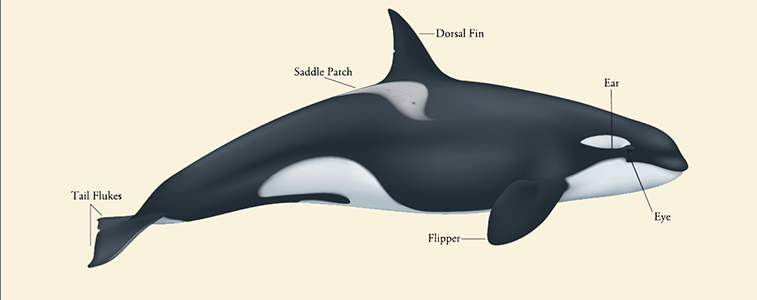Peanut head: What is it, when does it happen, and what are the causes?
CONTENT WARNING: Contains photographs of severely emaciated killer whales.
Several weeks ago, K21, the oldest male killer whale (orca) in the Southern Resident community, was photographed and videoed in a state of severe emaciation, showing an extreme version of what killer whale researchers sometimes refer to as “peanut head.”
Southern Resident orca, J28, with “peanut head” swimming with her malnourished calf, J54 (October 2, 2016/CWR Encounter #110). J28 is estimated to have died between October 16 and 18.
This term “peanut head” comes from the fact that, as killer whales lose their fat reserves, the fatty tissue behind their head recedes, giving them a peanut-shaped profile at the surface.
While K21 was emaciated, the other whales in K pod generally looked healthy when Center for Whale Research (CWR) researchers photographed them from shore. This is not necessarily rare: researchers often find that a whale may be severely emaciated while their family members appear relatively healthy. This makes “peanut head” and the extremely poor body condition underlying it a bit of a mystery.
One thing is very clear: Whales with “peanut head” are very unhealthy.
One thing is very clear: Whales with “peanut head” are very unhealthy. The majority of whales determined to be showing “peanut head” die quite soon after. However, recovery from mild cases is possible. The question then becomes: Do these whales die because they are malnourished? Or is this extreme emaciation a symptom of another underlying condition that leads to their death?
A recent review of killer whale (orca) necropsies suggests that malnutrition may often be the ultimate cause of death in these animals. Of the seven whales this study classified as having “poor” body condition, malnutrition was considered the cause of death in five; two were due to systemic infections.
This opens up another mystery: Why are these whales malnourished while their family members are not? One potential answer is an infection or other illness. The Southern Residents are exposed to numerous infectious agents in their urban habitat, and their respiratory microbiome is filled with potentially pathogenic bacteria. The same review that identified significant malnutrition as a cause of death for several killer whales (orcas) also identified several infections in these deceased whales.

Southern Resident orca, J50, showing “peanut head” (July 29, 2018/CWR Encounter #55).
Importantly, however, long-term monitoring by CWR and Fisheries and Oceans Canada (DFO) has revealed that killer whale survival is tightly linked to the abundance of their primary prey, Chinook salmon. Killer whales may be more vulnerable to various illnesses when they have less to eat. Especially if they carry a high level of pollutants such as polychlorinated biphenyls (PCBs) in their blubber.
One of the many effects these toxins can have is suppressing the animal’s immune systems, making them more vulnerable to infection. These illnesses may then have a feedback effect, making it harder for the orcas to catch and digest food.
We still don’t really know why particular killer whales show up in our study area emaciated. But based on what we do know, we can hypothesize a bit: Poor nutrition, due to prey shortage, results in increased circulating PCBs as the whale metabolizes the blubber that these toxins are trapped in. These toxins suppress the whale’s immune system, making it more vulnerable to infections. These infections then make it harder for the whale to catch and digest food, leading to “peanut head” and, in many cases, death.
A recent review of killer whale (orca) necropsies suggests that malnutrition may often be the ultimate cause of death in these animals.
The threats the killer whales (orcas) face are all intertwined and interact in frightening ways. While many actions may be helpful, the most important thing we can do is increase the Chinook salmon available to the Southern Resident killer whales.
Thirty-five-year-old Southern Resident orca, K21, exhibiting an extreme case of “peanut head” (July 28, 2021).
**If you are reading theOrcasonian for free, thank your fellow islanders. If you would like to support theOrcasonian CLICK HERE to set your modestly-priced, voluntary subscription. Otherwise, no worries; we’re happy to share with you.**










